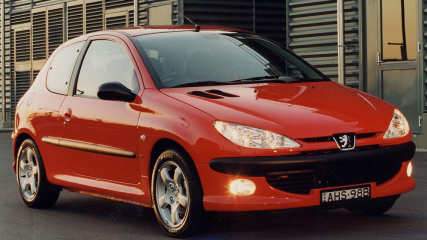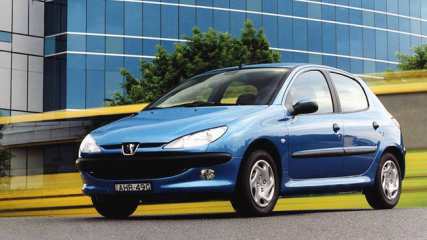Used Peugeot 206 review: 2001-2004
By Graham Smith · 29 Jan 2009
With its folding steel roof Peugeot’s 206CC was two cars in one, combining the fun of a convertible with the comfort and security of a coupe. It wasn’t the first car to feature a retractable steel roof, the Americans were toying with the concept in the 1950s before Mercedes really nailed it with the SLK in the ’90s, but the cute Peugeot was the first to make it an affordable alternative to the rag top.Traditional convertibles had folding fabric tops, but there are a number of deficiencies in a soft top. They don’t provide much, if any, noise insulation, they often leak and can be slashed by someone intent on breaking into your car, and those foggy plastic rear windows are just a pain. On top of that they contribute nothing to a car’s structure at all.A steel roof, on the other hand, doesn’t leak, it can be as quiet as a regular coupe or sedan, afford a greater level of security, and can contribute to a car’s strength by dint of its rigid panels.MODEL WATCHThe arrival of the CC – coupe cabriolet – version of Peugeot’s little 206 came as a surprise.Mercedes-Benz had shown a folding steel roof was plausible with the SLK sports car, but the idea of employing the apparently expensive concept on a cheaper model wasn’t really considered a possibility.It’s really a brilliant concept. With the steel roof in the raised position the occupants are afforded the comfort and protection of a coupe, but it’s also possible to lower the roof to reveal a fun convertible in a matter of a few seconds.If there’s a downside to the concept it’s that you lose more than half of the boot space you might otherwise use for carrying luggage, shopping or what have you when the roof is folded away.The 206CC sat on the same wheelbase and track as its sedan cousins; it also shared the same front floorpan and drivetrain with the more modest models in the 206 range.It didn’t matter which way you viewed it the 206CC was cute, a mix of form, fashion and function with a roof that disappeared from view in 20 seconds at the touch of a button on the console.Inside it had four seats, but in reality it was a two-seater with rear seats suitable only for occasional use.The seats, dash and door panels were lifted from the 206 sedan, but the rear is unique to the CC.Under the cute curves lay a form of MacPherson Strut front suspension, with an anti-roll bar, and a system of torsion bars at the rear, also with an anti-roll bar. On the road it had a comfortable ride and it handled with aplomb.Steering was power assisted rack and pinion, while brakes were disc front and rear with the assistance of anti-skid control and electronic brake force distribution to ensure optimum brake effort where it was most needed.Two engines were on offer, a 1.6-litre double overhead camshaft fuel-injected four-cylinder unit that was linked to a four-speed auto, and a 2.0-litre double overhead camshaft fuel-injected four that came with a five-speed manual gearbox.The 1.6-litre engine developed 80 kW at 5800 revs along with 147 Nm at 4000 revs, while the larger engine made 100 kW at 6000 revs and 194 Nm at 4000 revs.On the road that translated into a 0-100 km/h sprint of 12.5 seconds for the 1.6 and 9.3s for the 2.0-litre model.Standard features included climate control air-conditioning, power windows and mirrors, cloth trimmed sports seats, drilled ‘rally’ style pedals, height adjustable steering column and driver’s seat, and remote central locking.IN THE SHOPThe earliest 206CCs are approaching the time for a timing belt change and it’s important it be changed at 80,000 km or four years, as a failure will result in some nasty internal damage to the engine.Check for a service record that can be verified, and look inside the oil filler cap for sludge, the enemy of all modern engines.Transmissions stand up quite well, as does the rest of the drivetrain, but brake wear can be high with discs expensive to replace.Check that the roof operates smoothly when being raised or lowered, if it doesn’t it could be because of poor crash repairs that have left it misaligned.The 206CC also suffered from some dash shake so expect a few rattles as time goes on. It’s not a major problem, but can be annoying.IN A CRASHDual front and side airbags provide comprehensive crash protection, while ant-skid brakes with brake force distribution add a further layer of dynamic primary protection.OWNERS SAYAfter Cheryle Fry told her husband she wanted a convertible for her next car, but that she also wanted a hard top, he went looking for something suitable. When she saw a photo of the 206CC she knew that was the one she wanted. Her husband agreed with great trepidation as being a bit of a car buff he had doubts about Peugeot reliability and build quality. After more than a year of ownership and numerous roof-down days on winery trips and joy rides she says the car has not given a moment of trouble. As the car does not carry a spare wheel her husband put Tyre Shield in the tyres many thousands of kilometres ago and she has never had a flat tyre. On a recent trip to Bathurst on mostly corrugated dirt roads with jagged rocks the car and tyres performed superbly. This car is everything I expected it to be and more!LOOK FOR• cute styling• smooth roof operation• comfort and convenience of folding steel roof• quite robust mechanicals• good level of crash protection• limited rear seat accommodationTHE BOTTOM LINEGood looking fun convertible with the convenience and security of a coupe.RATING70/100








